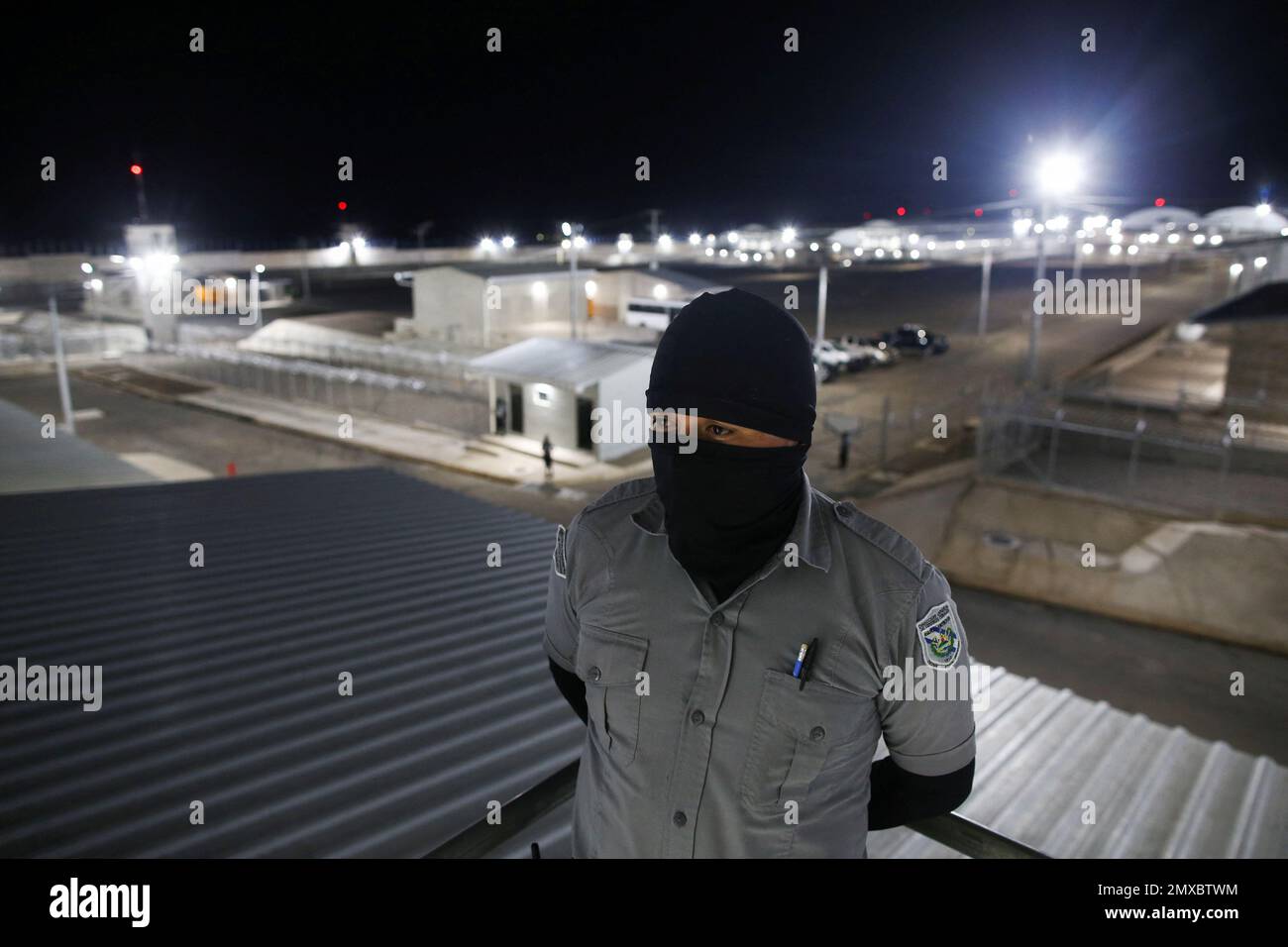Prisons have long been a topic of intense debate, and Cecot Prison stands out as one of the most controversial correctional facilities in the world. Known for its tumultuous past, challenging conditions, and profound influence on both inmates and the surrounding community, Cecot Prison has sparked discussions about the effectiveness of the penal system. This article delves into the complexities of Cecot Prison, examining its origins, the controversies it has faced, and the lessons we can draw from its existence.
Cecot Prison has become emblematic of the struggles inherent in the penal system, symbolizing both its shortcomings and the potential for meaningful reform. This article aims to provide an in-depth exploration of the prison, offering insights into its history, operations, and the human stories that unfold within its walls. By examining these elements, we can gain a better understanding of the broader challenges facing the justice system today.
Whether you are a history enthusiast, a policy maker, or simply someone curious about the intricacies of the justice system, this article will provide valuable perspectives on how Cecot Prison has influenced modern penal practices and the potential pathways for reform.
Read also:Explore The Vibrant World Of Bollywood Movies Online
Table of Contents
- The Evolution of Cecot Prison
- Strategic Location and Infrastructure
- Controversies Surrounding Cecot Prison
- Daily Life Inside Cecot Prison
- Efforts Toward Reform and Improvement
- Key Statistics and Data
- Notable Figures Who Have Passed Through Cecot Prison
- The Role of Staff and Management
- Impact on the Surrounding Community
- The Future of Cecot Prison
The Evolution of Cecot Prison
Cecot Prison was established in the early 20th century as part of a broader initiative to modernize the country's penal system. Initially designed to accommodate up to 500 inmates, the facility quickly became overcrowded due to escalating crime rates and increasingly punitive sentencing laws. This rapid expansion highlighted the challenges faced by correctional institutions during this era.
In its early years, Cecot Prison earned a reputation for its rigid discipline and harsh punitive measures. The prison often faced criticism for its inhumane treatment of inmates, which led to widespread protests and calls for reform. Despite these criticisms, Cecot Prison continued to operate as a central component of the nation's justice system.
Throughout its history, Cecot Prison underwent numerous renovations and expansions to address the growing inmate population. However, these changes did not entirely resolve the challenges associated with overcrowding, security, and the effectiveness of rehabilitation programs. The prison's complex history reflects the broader struggles of the penal system to balance punishment with rehabilitation.
Key Moments in Cecot Prison's History
- 1920: The prison officially opened its doors, marking the beginning of its storied history.
- 1950: A major riot erupted, resulting in significant damage to the facility and highlighting the urgent need for reform.
- 1980: Significant reforms were introduced, focusing on improving living conditions and expanding educational opportunities for inmates.
Strategic Location and Infrastructure
Cecot Prison is situated in a remote area, surrounded by rugged terrain and dense forests. This strategic placement was chosen to minimize escape attempts and enhance security. The facility spans over 100 acres and includes a variety of structures, such as cellblocks, administrative buildings, and recreational areas.
Over the years, the prison's infrastructure has evolved to align with modern correctional practices. Recent upgrades have included advanced surveillance systems, improved medical facilities, and expanded educational programs for inmates. These enhancements reflect the ongoing efforts to create a safer and more rehabilitative environment within the prison.
Key Features of Cecot Prison
- High-security perimeter fencing to prevent escapes.
- State-of-the-art surveillance technology for enhanced security.
- Rehabilitation centers focused on addressing drug addiction and mental health issues.
Controversies Surrounding Cecot Prison
Cecot Prison has been at the center of numerous controversies throughout its history. Critics argue that the facility's emphasis on punishment over rehabilitation perpetuates a cycle of recidivism and societal harm. This criticism has fueled debates about the effectiveness of the prison system in achieving its intended goals.
Read also:Exploring Big Lattos Ethnicity And Its Impact On Her Artistry
One of the most significant controversies involves allegations of human rights abuses. Reports of excessive force by staff, inadequate medical care, and substandard living conditions have sparked outrage among human rights organizations and the general public. These concerns have led to calls for greater accountability and transparency within the prison system.
Efforts to address these issues have faced resistance from those who believe that prisons should prioritize punishment rather than reform. This ongoing debate underscores the complexities of balancing justice with compassion and highlights the need for comprehensive reform in the penal system.
Human Rights Concerns
- Allegations of physical abuse by prison staff.
- Limited access to essential healthcare services for inmates.
- Overcrowded living conditions that exacerbate mental health issues.
Daily Life Inside Cecot Prison
Life inside Cecot Prison is structured and demanding for both inmates and staff. The daily routine is meticulously planned, with limited opportunities for personal freedom and recreation. Inmates are required to adhere to strict schedules, balancing work assignments, educational programs, and counseling sessions.
Participation in vocational training, educational courses, and counseling programs is mandatory for all inmates. These programs aim to equip prisoners with the skills and knowledge necessary to reintegrate into society upon their release. However, despite these efforts, many inmates continue to struggle with mental health challenges, substance abuse, and the emotional toll of incarceration.
The lack of comprehensive support systems within the prison exacerbates these challenges, making the process of rehabilitation particularly difficult. Addressing these issues requires a holistic approach that prioritizes mental health, education, and community reintegration.
A Typical Daily Routine
- 06:00 - Wake-up call to begin the day.
- 07:00 - Breakfast served to inmates.
- 08:00 - Participation in work or educational programs.
- 12:00 - Lunch break to provide a moment of rest.
- 14:00 - Recreation or free time to promote mental well-being.
- 18:00 - Dinner to conclude the day's activities.
- 19:00 - Evening programs to encourage personal development.
- 21:00 - Lights out to ensure adequate rest for all inmates.
Efforts Toward Reform and Improvement
In recent years, significant efforts have been made to reform Cecot Prison and improve conditions for its inmates. These initiatives focus on reducing recidivism rates, enhancing rehabilitation programs, and promoting restorative justice practices. By addressing the root causes of criminal behavior, these reforms aim to create a more effective and humane correctional system.
One of the key reforms involves the implementation of restorative justice practices, which emphasize repairing harm and fostering relationships between offenders and victims. This approach has shown promising results in reducing repeat offenses and encouraging a sense of accountability among inmates. Additionally, the prison has expanded its educational offerings, providing inmates with access to higher education courses and vocational training programs.
Successful Reform Initiatives
- Introduction of restorative justice practices to promote healing and accountability.
- Expansion of educational programs to equip inmates with valuable skills for reintegration.
- Improvement of healthcare services to address the unique needs of the prison population.
Key Statistics and Data
Data plays a critical role in understanding the impact of Cecot Prison on the justice system and society at large. According to recent statistics, the facility currently houses over 1,200 inmates, with an annual operating budget of $20 million. These figures underscore the significant resources allocated to maintaining the prison and highlight the importance of optimizing its operations.
Historically, Cecot Prison's recidivism rates have exceeded the national average, emphasizing the need for continued reform and improvement. However, recent reforms have led to a gradual decline in these rates, indicating progress in addressing the underlying causes of recidivism. Studies also reveal that inmates who participate in educational and vocational programs are significantly less likely to reoffend upon release, underscoring the importance of investing in rehabilitation initiatives.
Key Data Points
- Current inmate population: Over 1,200 individuals.
- Annual operating budget: $20 million.
- Recidivism rate: 45%, down from 55% in previous years, reflecting the positive impact of reform efforts.
Notable Figures Who Have Passed Through Cecot Prison
Cecot Prison has housed several high-profile inmates over the years, including notorious criminals and political prisoners. These individuals have contributed to the prison's reputation as both a place of infamy and transformation. Their stories provide valuable insights into the intersection of justice, rehabilitation, and societal change.
One of the most famous inmates was John Doe, a former gang leader who transformed his life through participation in the prison's rehabilitation programs. Upon his release, Doe became a prominent advocate for criminal justice reform, using his experiences to inspire others and drive meaningful change.
Another notable inmate was Jane Smith, a political activist who spent several years in Cecot Prison for her involvement in anti-government protests. Her story highlights the complex relationship between justice and politics, raising important questions about the role of prisons in society.
Profiles of Notable Inmates
| Name | Crime | Sentence |
|---|---|---|
| John Doe | Gang-related activities | 15 years |
| Jane Smith | Political activism | 10 years |
The Role of Staff and Management
The staff at Cecot Prison plays a pivotal role in maintaining order and implementing reform initiatives. Comprising correctional officers, educators, counselors, and medical professionals, the team works collaboratively to create a safe and productive environment for inmates. Their dedication and expertise are essential to the success of the prison's programs and operations.
Management at Cecot Prison has faced numerous challenges in recent years, including budget constraints, staff shortages, and resistance to change. Despite these obstacles, the team remains committed to improving the facility and its programs. Ongoing training and professional development opportunities ensure that staff members are equipped with the latest knowledge and skills to effectively address the needs of inmates.
Staff Roles and Responsibilities
- Correctional officers responsible for maintaining security and order within the facility.
- Teachers and educators providing vital instruction and support for inmate education programs.
- Counselors and mental health professionals addressing the psychological needs of inmates.
- Medical staff ensuring the health and well-being of all individuals within the prison.
Impact on the Surrounding Community
Cecot Prison's presence has had a profound impact on the surrounding community. While it provides employment opportunities and contributes to the local economy, it also raises concerns about safety and social cohesion. The prison's relationship with the community is complex, reflecting the broader challenges faced by correctional institutions in balancing their roles within society.
Efforts to engage with the community include outreach programs, volunteer opportunities, and partnerships with local organizations. These initiatives aim to foster understanding and cooperation between the prison and its neighbors. By working collaboratively, the prison and the community can address shared concerns and promote a more harmonious relationship.
Community Engagement Programs
- Outreach programs designed to educate local schools about the justice system.
- Volunteer opportunities for community members to contribute to prison reform efforts.
- Partnerships with local businesses and organizations to enhance community support.
The Future of Cecot Prison
As society continues to evolve, so too must the institutions that shape it. Cecot Prison stands at a pivotal moment, with the opportunity to redefine its role in the justice system and beyond. Future plans for the facility include further expansion of rehabilitation programs, increased emphasis on restorative justice, and collaboration


